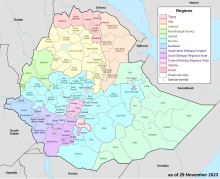West Gojjam(Amharic:ምዕራብ ጎጃም) orMirab Gojjamis a Zone in theAmhara RegionofEthiopia.It is named after the former province ofGojjam.
West Gojjam
ምዕራብ ጎጃም | |
|---|---|
 | |
 | |
| Country | Ethiopia |
| Region | Amhara Region |
| Largest city | Bahir Dar |
| Area | |
• Total | 13,311.94 km2(5,139.77 sq mi) |
| Population (2007) | |
• Total | 2,106,596 |
| • Density | 160/km2(410/sq mi) |

West Gojjam is bordered on the south by theAbay Riverwhich separates it from theOromia RegionandBenishangul-Gumuz Region,on the west byAgew Awi,on the north and northwest byNorth Gondarand also on the north bySouth Gondar,and on the east byEast Gojjam.Its highest point isMount Amedamit.Towns in West Gojjam includeBahir Dar,Adet,Finote Selam,Bure,Quarit,Dega Damot,Sekela,Merawi,andDembecha.Finote Selamis the capital of the zone.
Demographics
editBased on the 2007 Census conducted by theCentral Statistical Agencyof Ethiopia (CSA), this Zone has a total population of 2,106,596, of whom 1,058,272 are men and 1,048,324 women; with an area of 13,311.94 square kilometers, West Gojjam has a population density of 158.25. While 184,703 or 8.77% are urban inhabitants, one person was reported to be a pastoralist. A total of 480,255 households were counted in this Zone, which results in an average of 4.39 persons to a household, and 466,491 housing units. The largest ethnic group reported in West Gojjam was theAmhara(99.42%); all other ethnic groups made up 0.52% of the population.Amharicis spoken as a first language by 99.43%; the remaining 0.57% spoke all other primary languages reported. 98.68% of the population said they practicedEthiopian Orthodox Christianity,and 1.19% wereMuslim.[2]
The 1994 national census reported a total population for this Zone of 1,779,723 in 374,115 households, of whom 897,215 were men and 882,508 women; 107,238 or 6.03% of its population were urban dwellers at the time. The largest ethnic group reported in West Gojjam was theAmhara(99.43%); all other ethnic groups made up 0.57% of the population.Amharicwas spoken as a first language by 99.46%; the remaining 0.54% spoke all other primary languages reported. 98.28% practicedEthiopian Orthodox Christianity,and 1.59% of the population said they wereMuslim.[3]
According to a May 24, 2004World Bankmemorandum, 6% of the inhabitants of West Gojjam have access to electricity, this zone has a road density of 56.7 kilometers per 1000 square kilometers (compared to the national average of 30 kilometers),[4]the average rural household has 1.1 hectare of land (compared to the national average of 1.01 hectare of land and an average of 0.75 for the Amhara Region)[5]and the equivalent of 0.7 heads of livestock. 19.5% of the population is in non-farm related jobs, compared to the national average of 25% and a Regional average of 21%. 61% of all eligible children are enrolled in primary school, and 11% in secondary schools. 40% of the zone is exposed tomalaria,and 38% toTsetse fly.The memorandum gave this zone a drought risk rating of 454.[6]
The Zonal Water Resource Development Office announced 29 July 2009 that it had completed construction of 943 wells and 89 springs in West Gojjam, which will benefit 331,000 people. Using funds from the government, localNGOsand the public, this program improved the rate of access toclean waterfor inhabitants in the Zone from 39% to 50.6%.[7]
Notes
edit- ^abGeohive: EthiopiaArchived2012-08-05 at theWayback Machine
- ^Census 2007 Tables: Amhara Region,Tables 2.1, 2.4, 2.5, 3.1, 3.2 and 3.4.
- ^1994 Population and Housing Census of Ethiopia: Results for Amhara Region,Vol. 1, part 1,Tables 2.1, 2.11, 2.14, 2.17 (accessed 6 April 2009)
- ^"Ethiopia - Second Road Sector Development Program Project",p.3 (World Bank Project Appraisal Document, published 19 May 2003)
- ^Comparative national and regional figures comes from the World Bank publication, Klaus Deininger et al. "Tenure Security and Land Related Investment", WP-2991(accessed 23 March 2006).
- ^World Bank,Four Ethiopias: A Regional Characterization(accessed 23 March 2006).
- ^"Potable water facilities begin service",Ethiopian News Agency,29 July 2009 (accessed 1 November 2009
